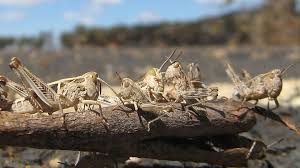Uganda’s ministry of agriculture has alerted all its districts bordering neighboring Kenya to be on the lookout and report immediately to the nearest extension staff in case of any strange grasshoppers detected in their areas.
This follows a locust invasion in the North Eastern Kenyan County of Mandera by December 2019.
Currently the locusts have spread to the six Counties of Mandera, Marsabit, Wajir, Garissa, Meru and Isiolo inside Kenya.
Uganda’s State Minister of Agriculture Aggrey Bagiire told journalists in Kampala on Monday that due to the security situation in Somalia and North Eastern Kenya (Mandera and Garissa Counties) and other factors, there are still large swarms of locusts observed from those countries and Ethiopia.
He however warned if not much is done and the locusts are allowed to move to the Turkana region, Uganda will be prone to the invasion especially the Karamoja and eastern region.
“Since the current control capacity is limited, some of the swarms could move further west into Turkana County, probably by mid-January 2020, with likely potential and risk that some swarms could spill over into the North Eastern region of Uganda, particularly Karamoja (borders Turkana County).” Bagire said.
Uganda needs about $1.4 million approximately to prepare an adequate response especially spraying craft in case of a locust invasion.
“The ministry has communicated to office of the Prime minister on the imminent Locust invasions and requested ministry of finance for provision of a contingency fund of 5 billion Uganda Shillings to cater for aircraft fuel), pesticides for control, provide for ground spray equipment and spray teams and to continuously create awareness to the population in case of an invasion.” said Bagiire.
He noted that Uganda is also working with regional bodies such as the Desert Locust Control Organization for Eastern Africa (DLCO EA) to share information on the current status of the desert locust in the region.
According to Bagiire, Uganda has sent a technical team of two in the Kenyan counties of Wajir and Marsabit to understudy the current locust control operations to subsequently share experiences and support the efforts in Uganda in case of any outbreak.
The Food and Agriculture Organization has warned that the current locust invasion would make it the worst invasion in 70 years.
Desert locust is a species of short-horned grasshopper family characterized by high mobility (migratory) and broad spectrum feeding habits.
According to FAO, the locusts have already destroyed 70,000 hectares about 175,000 acres of farmland in Somalia and Ethiopia, threatening food supplies in both countries.
CN/as/APA


